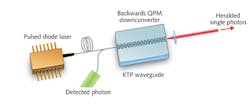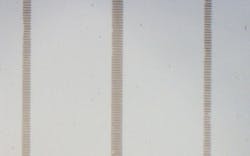NONLINEAR OPTICS: NLO waveguide structures advance quantum communications
Researchers developing the next generation of quantum-communication technology are increasingly using waveguided nonlinear optic (NLO) crystal structures as the basis for creating the photon transmitters and repeaters necessary for the high-security quantum-communications market. The addition of waveguides to periodically poled structures allows so-called paired photons to be generated much more efficiently; these paired photons are essential to complex quantum concepts (for example, those based on entangled and heralded photons) designed to achieve the performance necessary for wide use.
Encrypted communications are based on the simple concept of using a defined basis for coding the communication—an "encryption key"—and providing this key to the receiving party to decode the transmission. Truly secure communications requires the remote generation of unconditionally secure encryption keys, which is not possible with classical cryptography. In classical cryptography, security of the encryption keys is dependent on computational processing speeds being too slow to provide a practical method of breaking the encryption, as well as the encryption algorithms not containing a flaw that makes them easier to break.
As long as the classical protocols used today have no flaws, they appear to be safe in terms of the processing speeds necessary to break them. However, flaws in encryption algorithms are often found and necessitate abandoning old algorithms roughly every decade. In addition, the keys are vulnerable to undetected interception during transmission or transport.
Provable security via quantum mechanics
Quantum mechanics, on the other hand, can be used to remotely create provably unconditionally secure encryption keys. It allows two parties to create a shared secret random key over an unsecure channel with the ability to detect with certainty the presence of any eavesdropper. Several companies (such as ID Quantique SA and MagiQ Technologies Inc.) now offer quantum-key distribution (QKD) systems, and small QKD networks exist as well-for instance, the DARPA Quantum Network in Boston, MA, running on 10 nodes over both fiber and free-space links.
Various preliminary setups using single-photon approaches have been demonstrated using bulk (nonwaveguided) poled NLO structures (from suppliers such as AdvR, Covesion, HC Photonics, and Gooch & Housego), greatly attenuated lasers, and other means; these setups have helped to identify obstacles to the introduction of practical and cost-effective QKD systems having long-term viability. For example, the current practical state of the art limits both fiber and free-space systems to lengths of about 100 miles due to optical losses and the lack of repeaters able to boost a quantum signal.
A broad range of R&D efforts in quantum communication has focused on spontaneous parametric downconversion (SPDC) as the basic technology for producing the quantum states necessary to achieve commercially viable performance. While other methods exist (for instance, the long-distance record for QKD over fiber relied on an attenuated laser to generate single photons), SPDC is the predominant means to produce useful quantum states, such as optical fields with exactly one photon, or advanced states such as entangled photon pairs.
In the SPDC process, a pump photon enters a nonlinear crystal or waveguide and with typical probability of 10-8 to 10-11 (depending on crystal length and whether it is bulk or waveguide) is destroyed and two new photons (with the same net energy) created. For the interaction to occur at the correct wavelengths, momentum must be conserved as well, which necessitates periodic poling of the crystal. In periodic poling, the sign of the nonlinear coefficient is permanently alternated along the crystal length via high-voltage engineering, with the period chosen such that the crystal takes up the mismatch in photon momentum for the particular interaction desired (known as quasi-phase-matching, or QPM).
Bulk periodically poled crystals have commonly been used for SPDC; however, the photon-pair generation rate in waveguides can be one or two orders of magnitude higher than that for bulk crystals for a given pump power. Waveguide-based architectures can also enable the creation of new functions to support a new generation of quantum experiments and devices.
Techniques to control and purify the quantum states of single-photon and photon-pair sources can benefit several potential applications, including atom-photon interactions, in which a quantum state is transferred from a photon to a single atom or vice versa; quantum memory, in which the quantum information on a photon is stored temporarily; quantum teleportation, in which a quantum state is transferred through an intermediate photon state, for instance from one atom to another; and quantum repeaters for quantum links over arbitrarily large distances.
Very narrow-bandwidth SPDC
A key to better photon sources is the ability to produce photons that are indistinguishable, both spectrally and temporally. Improved techniques are being pursued that may lead to very narrow-bandwidth SPDC for spectral indistinguishability, such as recently introduced AdvR designs using backwards QPM, and AdvR longer-term championing of a Bragg-grating enhanced SPDC design.
In backward QPM, the poling period of the waveguide is chosen to take up the momentum mismatch of counterpropagating photons (see Fig. 1). While very small grating periods on the scale of 1 μm or less (see Fig. 2) are required to make this method efficient, the bandwidth is much narrower than the normal copropagating process (see Fig. 3).High-security quantum-communication markets are forecast (Market ResearchMedia.com) to reach multibillion-dollar annual levels by 2020. To attain the market's full potential, the use of spontaneous parametric downconversion in periodically poled NLO crystal structures is expected to be the foundational technology for producing the required quantum states.
The addition of waveguides to bulk periodically poled NLO structures has many advantages, such as an increase in photon generation rate by one or two orders of magnitude. These advances not only provide the basis for suitable photon sources but may also be critical in creating quantum repeaters for extending the lengths of fiber links, and quantum memory for data storage—an equally large new market opportunity.
Tony Roberts | Senior Scientist, AdvR
Tony Roberts is a senior scientist at AdvR (Bozeman, MT).
Bob Tamosaitis | President, AdvR
Bob Tamosaitis is the president at AdvR (Bozeman, MT).



